The AMD Radeon R9 Fury Review, Feat. Sapphire & ASUS
by Ryan Smith on July 10, 2015 9:00 AM ESTMeet The Sapphire Tri-X R9 Fury OC
Today we’ll be looking at Fury cards from both Sapphire and Asus. We’ll kick things off with Sapphire’s card, the Tri-X R9 Fury OC.
| Radeon R9 Fury Launch Cards | |||||
| ASUS STRIX R9 Fury | Sapphire Tri-X R9 Fury | Sapphire Tri-X R9 Fury OC | |||
| Boost Clock | 1000MHz / 1020MHz (OC) |
1000MHz | 1040MHz | ||
| Memory Clock | 1Gbps HBM | 1Gbps HBM | 1Gbps HBM | ||
| VRAM | 4GB | 4GB | 4GB | ||
| Maximum ASIC Power | 216W | 300W | 300W | ||
| Length | 12" | 12" | 12" | ||
| Width | Double Slot | Double Slot | Double Slot | ||
| Cooler Type | Open Air | Open Air | Open Air | ||
| Launch Date | 07/14/15 | 07/14/15 | 07/14/15 | ||
| Price | $579 | $549 | $569 | ||
Sapphire is producing this card in two variants, a reference clocked version and a factory overclocked version. The version we’ve been sampled is the factory overclocked version, though other than some basic binning to identify cards that can handle being overclocked, the two cards are physically identical.
As far as Sapphire’s overclock goes, it’s a mild overclock, with the card shipping at 1040MHz for the GPU while the memory remains unchanged at 1Gbps. As we discussed in our R9 Fury X review, Fiji cards so far don’t have much in the way of overclocking headroom, so AMD’s partners have to take it easy on the factory overclocks. Sapphire’s overclock puts the upper-bound of any performance increase at 4% – with the real world gains being smaller – so this factory overclock is on the edge of relevance.
Getting down to the nuts and bolts then, Sapphire’s card is a semi-custom design, meaning Sapphire has paired an AMD reference PCB with a custom cooler. The PCB in question is AMD’s PCB from the R9 Fury X, so there’s little new to report here. The PCB itself measures 7.5” long and features AMD’s 6 phase power design, which is designed to handle well over 300W. For overclockers there is still no voltage control options available for this board design, though as Sapphire has retained AMD’s dual BIOS functionality there’s plenty of opportunity for BIOS modding.
The real story here is Sapphire’s Tri-X cooler, which gets the unenviable job of replacing AMD’s closed loop liquid cooler from the R9 Fury X. With a TBP of 275W Sapphire needs to be able to dissipate quite a bit of heat to keep up with Fiji, which has led to the company using one of their Tri-X coolers. We’ve looked at a few different Tri-X cards over the years, and they have been consistently impressive products. For the Tri-X R9 Fury, Sapphire is aiming for much the same.
Overall the Tri-X cooler used on the Tri-X R9 Fury ends up being quite a large cooler. Measuring a full 12” long it runs the length of the PCB and then some, meanwhile with that much copper and aluminum it’s not a light card either. The end result is that with such a large cooler the card is better defined as a PCB mounted on a cooler than a cooler mounted on a PCB, an amusing juxtaposition from the usual video card. As a result of this Sapphire has gone the extra mile to ensure that the PCB can support the cooler; there are screws in every last mounting hole, there’s a full-sized backplate to further reinforce the card, and the final 4.5” of the cooler that isn’t mounted to the PCB has its own frame to keep that secure as well.
Moving to the top of the card, the Tri-X R9 Fury features three of Sapphire’s 90mm “Aerofoil” fans, the company’s larger, dual ball bearing fans. These fans are capable of moving quite a bit of air even when moving at relatively low speeds, and as a result the overall card noise is kept rather low even under load, as we’ll see in full detail in our benchmark section.
Meanwhile Sapphire has also implemented their version of zero fan speed idle on the Tri-X R9 Fury, dubbed Intelligent Fan Control, which allows the card to turn off its fans entirely when their cooling capacity isn’t needed. With such a large heatsink the Fiji GPU and supporting electronics don’t require active cooling when idling, allowing Sapphire to utilize passive cooling and making the card outright silent at idle. This is a feature a number of manufacturers have picked up on in the last couple of years, and the silent idling this allows is nothing short of amazing. For Sapphire’s implementation on the Tri-X R9 Fury, what we find is that the fans finally get powered up at around 53C, and power down when the temperature falls below 44C.
| Sapphire Tri-X R9 Fury Zero Fan Idle Points | ||||
| GPU Temperature | Fan Speed | |||
| Turn On | 53C | 27% | ||
| Turn Off | 44C | 23% | ||
Helping the cooling effectiveness of the Tri-X quite a bit is the length of the fans and heatsink relative to the length of the PCB. With the 4.5” of overhang, the farthest fan is fully beyond the PCB. That means that all of the air it pushes through the heatsink doesn’t get redirected parallel to the card – as is the case normally for open air cards – but rather the hot air goes straight through the heatsink and past it. For a typical tower case this means that hot air goes straight up towards the case’s exhaust fans, more efficiently directing said hot air outside of the case and preventing it from being recirculated by the card’s fans. While this doesn’t make a night & day difference in cooling performance, it’s a neat improvement that sidesteps the less than ideal airflow situation the ATX form factor results in.
Moving on, let’s take a look at the heatsink itself. The Tri-X’s heatsink runs virtually the entire length of the card, and is subdivided into multiple segments. Connecting these segments are 7 heatpipes, ranging in diameter between 6mm and 10mm. The heatpipes in turn run through both a smaller copper baseplate that covers the VRM MOSFETs, and a larger copper baseplate that covers the Fiji GPU itself. Owners looking to modify the card or otherwise remove the heatsink will want to take note here; we’re told that it’s rather difficult to properly reattach the heatsink to the card due to the need to perfectly line up the heatsink and mate it with the GPU and the HBM stacks.
The Tri-X R9 Fury’s load temperatures tend to top out at 75C, which is the temperature limit Sapphire has programmed the card for. As with the R9 Fury X and the reference Radeon 290 series before that, Sapphire is utilizing AMD’s temperature and fan speed target capabilities, so while the card will slowly ramp up the fan to 75C, once it hits that temperature it will more greatly ramp up the fan to keep the temperature at or below 75C.
Moving on, since Sapphire is using AMD’s PCB, this means the Tri-X also inherits the former’s BIOS and lighting features. The dual-BIOS switch is present, and Sapphire ships the card with two different BIOSes. The default BIOS (switch right) uses the standard 300W ASIC power limit and 75C temperature target. Meanwhile the second BIOS (switch left) Increases the power and temperature limits to 350W and 80C respectively, for greater overclocking limits. Note however that this doesn’t change the voltage curve, so Fury cards in general will still be held back by a lack of headroom at stock voltages. As for the PCB’s LEDs, Sapphire has retained those as well, though they default to blue (sapphire) rather than AMD red.
Finally, since this is the AMD PCB, display I/O remains unchanged. This means the Tri-X offers 3x DisplayPorts along with a single HDMI 1.4 port.
Wrapping things up, the OC version we are reviewing today will retail for $569, $20 over AMD’s MSRP. The reference clocked version on the other hand will retail at AMD’s MSRP of $549, the only launch card that will be retailing at this price. Finally, Sapphire tells us that the OC version will be the rarer of the two due to its smaller run, and that the majority of Tri-X R9 Fury cards that will be on sale will be the reference clocked version.


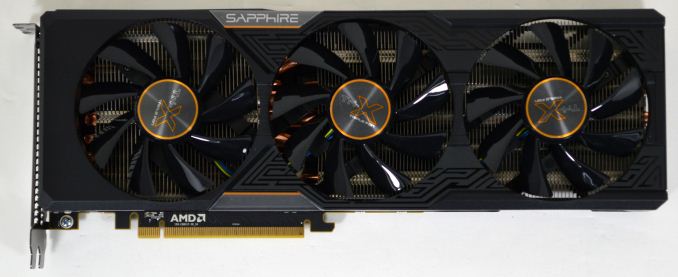
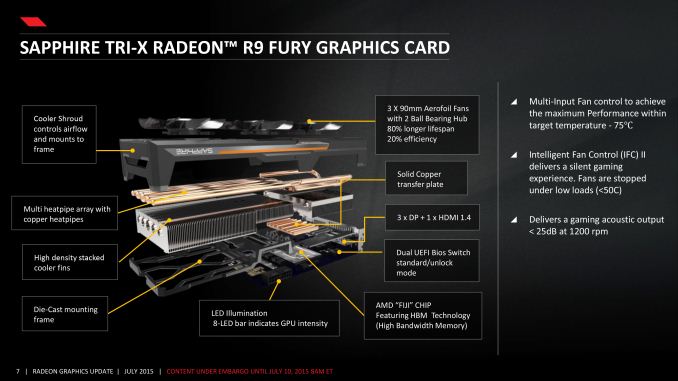
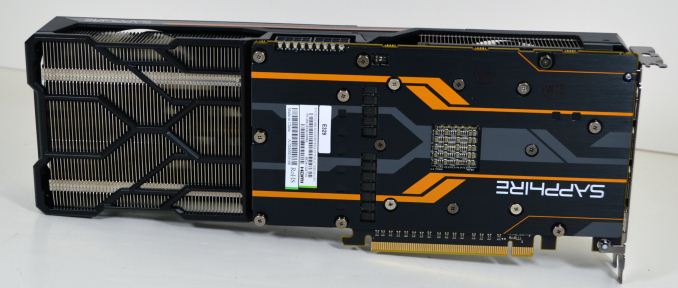
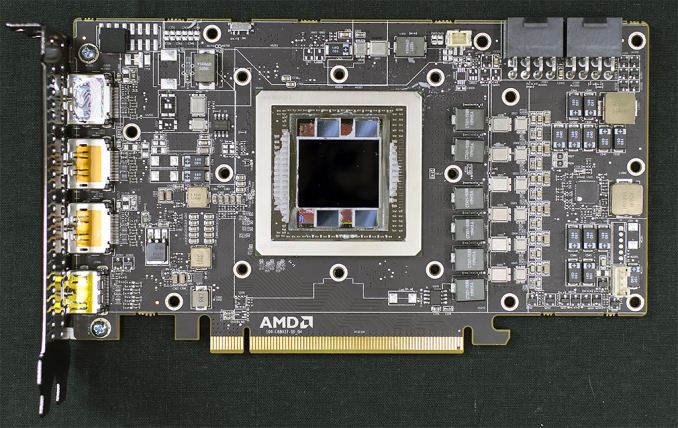


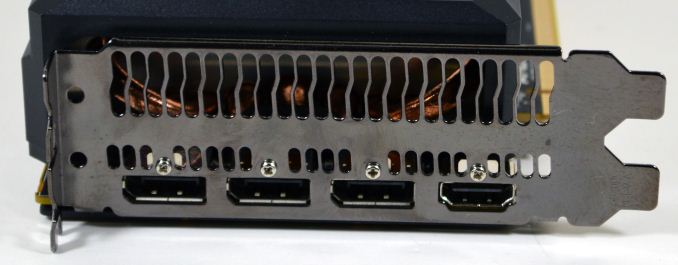








288 Comments
View All Comments
Socius - Saturday, July 11, 2015 - link
Yes...comparing an overclocked 3rd party pimped model against a non-OC'd reference design card that is $100 less in price and then saying it's a tough choice between the 2 as the R9 Fury is faster than the GTX 980...lol...totally balanced perspective there bro.Ryan Smith - Saturday, July 11, 2015 - link
Whenever a pure reference card isn't available, like is the case for R9 Fury, we always test a card at reference clockspeeds in one form or another. For example in this article we have the ASUS STRIX, which ships at reference clockspeeds. No comparisons are made between the factory overclocked Sapphire card and the GTX 980 (at the most we'll say something along the lines of "both R9 Fury cards", where something that is true for the ASUS is true for the Sapphire as well).And if you ever feel like we aren't being consistent or fair on that matter, please let us know.
Socius - Saturday, July 11, 2015 - link
I just want to understand something clearly. Are you saying that when you are talking about performance/value, you ignore the fact that one card can OC 4%, and the other can OC 30% as you don't believe it's relevant? Let me pose the question another way. If you had a friend who was looking to spend $500~ on a card and was leaning between the R9 Fury and the GTX 980. Knowing that the GTX 980 will give him better performance once OC'd, at $450, would you even consider telling him to get the R9 Fury at $550?My concern here is that you're not giving a good representation of real world performance gamers will get. As a result, people get misled into thinking spending the extra money on the R9 Fury is actually going to net them higher frame rate...not realizing they could get better performance, for even less money, if someone decided to actually look at overclocking potential...
Now if you weren't interested in overclocking results in general, I'd say fine. I disagree, but it's your choice. But then you do show overclocking results with the R9 Fury. I'm finding it really hard to understand what your intent is with these articles, if not to educate people and help them make an actual informed decision when making their next purchase.
As I mentioned in your previous article on the Fury X...you seem to have a soft spot for AMD. And I'm not exactly sure why. I will admit that I'm currently a big Nvidia fan. Only because of the features and performance I get. If the Fury X had come out, and could OC like the 980ti and had 8gb HBM memory, I'd have become an AMD fan. I'm a fan of whoever has the best technology at any given moment. And if I were looking to make a decision on my next card purchase, your article here would give a false impression of what I would get if I spent $100 more on an R9 fury, than on a GTX 980...
jardows2 - Saturday, July 11, 2015 - link
Apparently, OC is your thing. I get it. There are plenty of OC sites that are just for you. For some of us, we really don't want to see how much we can shorten the life of something we pay good money for, when the factory performance does what we need. I, for one, am more interested in how something will perform without me potentially damaging my computer, and I appreciate the way that AT does their benchmarks.Socius - Saturday, July 11, 2015 - link
I think the fact that you believe overclocking will "damage your computer" or in any meaningful way shorten the lifespan of the product, is all the more reason to talk about overclocking. I'd be more than welcome to share a little info.Generally speaking, what kills the product is heat (minus high current degradation that was a bigger problem on older fab processes) So let's say you have a GPU that runs 60 degrees Celsius under load, at 1000MHz with a 50% fan speed profile. Now let's imagine 2 scenarios:
1) You underclock the GPU to 900MHz and set a 30% fan profile to make your system more quiet. Under load, your GPU now hits 70 degrees Celsius.
2) You overclock the GPU to 1100MHz and set a 75% fan profile for more performance at the cost of extra sound. Under load, your GPU now hits 58 degrees Celsius due to increased fan speed.
Which one of these devices would you think is likely to last the longest? If you said the Overclocked one, you'd be correct. In fact...the overclocked one is likely to last even longer than the stock 1000MHz at the 50% fan speed profile, because despite using more power and giving more performance, the fan is working harder to keep it cooler, thus reducing the stress on the components.
Now. Let's talk about why that card was clocked at 1000MHz to start! When a chip is designed, the exact clock speed is an unknown. Not just between designs...but between individual wafers and dies cut out from those wafers. As an example, I had an i7 3770k that would use 1.55v to hit 4.7GHz. I now have one that uses 1.45v to hit 5.2GHz and 1.38v to hit 5GHz. Why am I telling you this? Well...because it's important! When designing a product like a CPU or GPU, and setting a base clock, you have to account for a few things:
1) How much power do I want to feed it?
2) How much of the heat generated by that power can I dissipate with my fan design?
3) How loud do I want my fan to be?
4) What's the highest clock rate my lowest end wafer can hit while remaining stable and at an acceptable voltage requirement?
So here's the fun part. So while chips themselves can vary greatly, there are tons of precautions added when dealing with stock speeds. Just for a point of reference...a single GTX Titan X is guaranteed to overclock 1400MHz-1550MHz with proper settings, if you put the fan at 100% full blast. That's a 30%-44% overclock! So why wouldn't Nvidia do that? Well it's a few things.
1) Noise! Super important here. Your clockspeed is determined by your ability to cool it. And if you're cooling by means of a fan, the faster that fan, the more noise, the more complaints by consumers.
2) Power/Heat variability. Since each chip is different, as you go into the higher ranges, each will require a different amount of power in order to be stable at that frequency. If you're curious, you can see what's called an ASIC quality for your GPU using a program like GPU-Z. This number will tell you roughly how good of a chip you have, in terms of how much of a clock it can achieve with how much power. The higher the % of your ASIC quality, the better overclocking potential you have on air because it'll require less power, and therefore create less heat to do it!
3) Overclocking potential. This is actually important in Marketing. And it's something AMD and Nvidia are both pretty bad at, actually. But AMD's bit a bit worse, to their own detriment. In their R9 Fury and Fury X press release performance numbers they set expectations for their cards to completely outperform the 980ti using best case scenarios and hand picked settings. And they also said it overclocks like a beast. Now...here's why that's bad. Customers like to feel they're getting more than what they pay for. That's why companies like BMW always list very modest 0-60 times for their cars. When I say modest, I mean they set the 0-60 times to show they're worse than what the car is actually capable of. That's why every car review program you see will show 0-60 times being 0.2 to 0.5 seconds faster than what BMW has actually listed. This works because you're sold on a great product, only to find it's even greater than that.
Got off track a bit there. I apologize. Back to AMD and the Fiji lineup and why this long post was necessary. When AMD announced the Fury X being an all in one cooler design, I instantly knew what was up. The chip wasn't able to hold up to the limitations we talked about above (power requirement/heat/fan noise/stability). But they needed to put out a stock clock that would allow the card to be competitive with Nvidia, but they also didn't want it to sound like a hair dryer. That's why they opted for the all in one cooler design. Otherwise, a chip that big on an air cooled design would likely have been clocked around the 850-900MHz range that the original GTX Titan had. But they wanted the extra performance, which created extra heat and required more power, and used a better cooler design to be able to accomplish that across the board with all their chips. That's great, right? Well...yes and no. I'll explain.
Essentially the Fiji lineup is "factory overclocked" by AMD. This is the same as putting a turbo on a car engine. And as any car enthusiast will tell you, a 2L engine with a turbo on it may be able to produce 330 horsepower, which could otherwise take a naturally aspirated 4L V8 to accomplish. But then you're limited for increased horsepower even further. Sure you could put a bigger supercharger on that 2L engine. But it already had a boosted performance for that size engine. So your gains will be minimal. But with that naturally aspirated engine...you can drop a supercharger on it and realize massive gains. This is very much the same as what's happening with the Fury X, for example.
And this is why I believe it's incredibly important to point this out. I built a system for my friend recently with a GTX 970. I overclocked that to 1550MHz on first try, without even maxing out the voltage. That was a $300 model card. And even that would challenge the performance of the R9 Fury if you don't plan on overclocking (not that you could, anyway, with that 4% overclock limit).
So...yes, I do think Overclocking needs to be talked about more, as it's become far easier and safer to do than in the past. Even if you don't plan to do extreme overclocking, you can keep all your fan speed automated profiles the same, don't touch voltage, and just increase power limit and a slight increase in the gpu clock for simple free performance. It's something I could teach my mom to do. So I hope it's something that is done by more and more people, as there's really no reason not to do it.
And that's why I think informing people of these differences with regard to overclocking will help people save money, and get more performance. And not doing just keeps people in the dark, and does them a great disservice. Why keep your audience oblivious and allow them to remain ignorant to these things when you can take some time to help them? Overclocking today is far different from the overclocking of a few years ago. And everybody should give it a try.
mdriftmeyer - Sunday, July 12, 2015 - link
Ryan is biased in these comparisons. That's a fact. Your knowledge silencing the person defending Ryan's unbalanced comparisons is a fact.jardows2 - Monday, July 13, 2015 - link
What a hoot! He didn't silence me. I just have better things to do on the weekend than check all the Internet forums I may have posted to!jardows2 - Monday, July 13, 2015 - link
@SociusThat was a good post explaining your interest in OC. From my perspective, I come from the days when OC'ing would void your warranty and would shorten the life span of your system. I also come from a more business and channel oriented background, meaning that we stay with "officially supported" configurations. That background stays with you. Even today, when building my personal computer or a web browsing computer for a family member, I do everything I can to stay with the QVL of the motherboard.
I am more concerned with out of box experience, and almost always skip over the OC results of benchmarks whenever they are presented. If a device can not perform properly OOB, then it was not properly configured from the start, which does not give me the best impression about the part, regardless of the potential of individual tweaks.
In the end, you are looking for OC results, I am only concerned with OOB experience. Different target audience, both with valid concerns. I just don't think it is worth bashing a reviewer's method that focuses on one experience over the other.
Mugur - Saturday, July 11, 2015 - link
Good review as always, Ryan. I wouldn't throw away Asus's approach. Nice power efficiency gains. Funny how overclocking for a few fps more heated the discussion... All in all, I think AMD is back in business with Fury non-X. Waiting for 3xx reviews, hopefully for the whole R9 line, with 2, 4 and 8 GB.3ogdy - Saturday, July 11, 2015 - link
What a disappointment again. Man...the Fury cards really aren't worth the hassle at all, are they? It's sad to see this, especially coming from an FX-8350 & 2xHD6950s owner. So the 980Ti beats the custom cards (we knew Fury X was quite at its limits from the beginning, but still - despite all the improvements, custom cards sometimes perform even worse than the stock one. The 980Ti really beats the Fury X most of the time.What is that, nVidia's blower is only 8dB louder than the highest end of the fans used by arguably the two best board partners AMD has? Wow! This is where I realize nVidia really must have done an amazing job with the 980Ti and Maxwell in general.
HBM this HBM that...this card is beaten at 4K by the GTX980Ti and gameplay seems to be smoother on the nVidia card too. What the hell? Where are the reasons to buy any of the Fury cards?